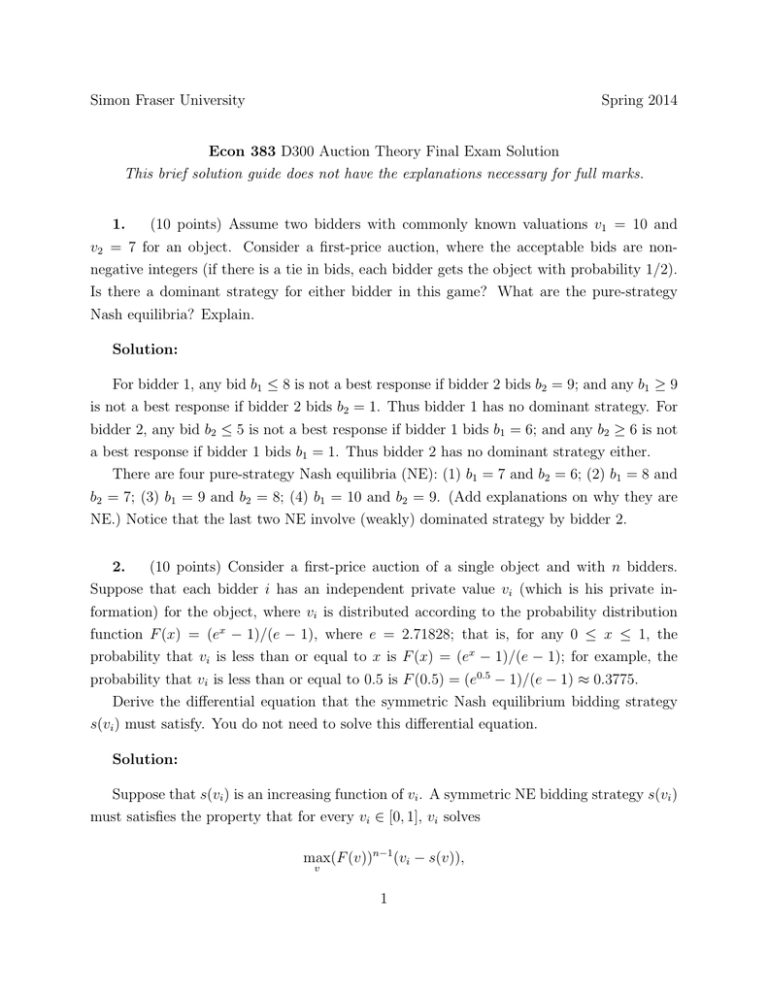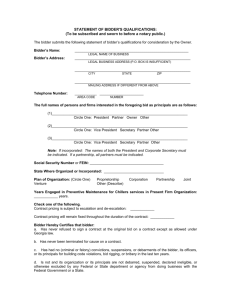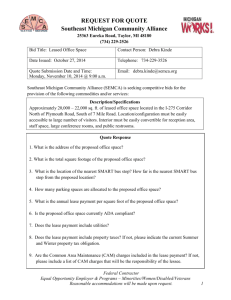Simon Fraser University Spring 2014
advertisement

Simon Fraser University
Spring 2014
Econ 383 D300 Auction Theory Final Exam Solution
This brief solution guide does not have the explanations necessary for full marks.
1.
(10 points) Assume two bidders with commonly known valuations v1 = 10 and
v2 = 7 for an object. Consider a first-price auction, where the acceptable bids are nonnegative integers (if there is a tie in bids, each bidder gets the object with probability 1/2).
Is there a dominant strategy for either bidder in this game? What are the pure-strategy
Nash equilibria? Explain.
Solution:
For bidder 1, any bid b1 ≤ 8 is not a best response if bidder 2 bids b2 = 9; and any b1 ≥ 9
is not a best response if bidder 2 bids b2 = 1. Thus bidder 1 has no dominant strategy. For
bidder 2, any bid b2 ≤ 5 is not a best response if bidder 1 bids b1 = 6; and any b2 ≥ 6 is not
a best response if bidder 1 bids b1 = 1. Thus bidder 2 has no dominant strategy either.
There are four pure-strategy Nash equilibria (NE): (1) b1 = 7 and b2 = 6; (2) b1 = 8 and
b2 = 7; (3) b1 = 9 and b2 = 8; (4) b1 = 10 and b2 = 9. (Add explanations on why they are
NE.) Notice that the last two NE involve (weakly) dominated strategy by bidder 2.
2.
(10 points) Consider a first-price auction of a single object and with n bidders.
Suppose that each bidder i has an independent private value vi (which is his private information) for the object, where vi is distributed according to the probability distribution
function F (x) = (ex − 1)/(e − 1), where e = 2.71828; that is, for any 0 ≤ x ≤ 1, the
probability that vi is less than or equal to x is F (x) = (ex − 1)/(e − 1); for example, the
probability that vi is less than or equal to 0.5 is F (0.5) = (e0.5 − 1)/(e − 1) ≈ 0.3775.
Derive the differential equation that the symmetric Nash equilibrium bidding strategy
s(vi ) must satisfy. You do not need to solve this differential equation.
Solution:
Suppose that s(vi ) is an increasing function of vi . A symmetric NE bidding strategy s(vi )
must satisfies the property that for every vi ∈ [0, 1], vi solves
max(F (v))n−1 (vi − s(v)),
v
1
where v in the above maximization problem is the value that bidder i can pretend to have
(by bidding s(v)). Thus we have the first order condition:
(n − 1)(F (v))n−2 F 0 (v)(vi − s(v)) + (F (v))n−1 (−s0 (v))|v=vi = 0,
i.e.,
(n − 1)F 0 (vi )(vi − s(vi )) − F (vi )s0 (vi ) = 0.
Since F (vi ) = (evi − 1)/(e − 1), F 0 (vi ) = evi /(e − 1). Thus we have the differential
equation
(n − 1)evi (vi − s(vi )) − (evi − 1)s0 (vi ) = 0
that the symmetric NE bidding strategy s(vi ) must satisfy.
3. (10 points) There are five buyers {x, y, z, w, u} and five objects {a, b, c, d, e}. The
valuations are given in Table 1. Assume that each buyer wants only one object. Find an
optimal matching, i.e., one that maximizes social welfare, and find a set of market-clearing
prices. Explain and/or show why your matching is optimal and why your prices are market
clearing.
Buyer
x
y
z
w
u
value for a value for b
3
3
4
1
3
2
5
2
3
3
value for c value for d value for e
2
1
1
1
1
0
0
0
0
2
1
2
2
1
2
Table 1
Solution:
Let us use the ascending-price auction: S = constricted set of buyers, N (S) = overdemanded set of objects (the choice S may differ):
2
Dorm
Student
Dorm
Student
0
a
x
3, 3, 2, 1, 1
1
a
x
3, 3, 2, 1, 1
0
b
y
4, 1, 1, 1, 0
0
b
y
4, 1, 1, 1, 0
0
c
z
3, 2, 0, 0, 0
0
c
z
3, 2, 0, 0, 0
0
d
w
5, 2, 2, 1, 2
0
d
w
5, 2, 2, 1, 2
0
e
u
3, 3, 2, 1, 2
0
e
u
3, 3, 2, 1, 2
Round 1: S = {y, z, w}, N (S) = {a}.
Dorm
Student
2
a
x
3, 3, 2, 1, 1
0
b
y
0
c
0
0
Round 2: S = {y, w}, N (S) = {a}.
Dorm
Student
3
a
x
3, 3, 2, 1, 1
4, 1, 1, 1, 0
0
b
y
4, 1, 1, 1, 0
z
3, 2, 0, 0, 0
0
c
z
3, 2, 0, 0, 0
d
w
5, 2, 2, 1, 2
0
d
w
5, 2, 2, 1, 2
e
u
3, 3, 2, 1, 2
0
e
u
3, 3, 2, 1, 2
Round 3: S = {y, w}, N (S) = {a}.
Round 4: S = {z, u}, N (S) = {b}.
3
Dorm
Student
3
a
x
3, 3, 2, 1, 1
1
b
y
4, 1, 1, 1, 0
0
c
z
3, 2, 0, 0, 0
0
d
w
5, 2, 2, 1, 2
0
e
u
3, 3, 2, 1, 2
Round 5: a perfect matching exists.
By construction, when the auction terminates, it gives a set of market-clearing prices:
pa = 3, pb = 1, pc = 0, pd = 0, pe = 0, and a perfect matching given by these prices is x–c,
y–d, z–b, w–a, u–e. A perfect matching given by any market-clearing prices must maximize
social welfare (proved in class).
4. (10 points) Suppose that there are two advertisers (B = {x, y}) and two advertisement slots (S = {1, 2}), and each advertiser wants only one slot. Here we consider general
valuation vi,j , where i ∈ S and j ∈ B, not necessarily multiplicative. The valuations vi,j ,
i ∈ S, are advertiser j’s private information.
(i) For what valuations is the matching (1–x, 2–y) social-welfare maximizing? For what
valuations is the matching (1–y, 2–x) social-welfare maximizing?
(ii) Describe the VCG mechanism for this setup. In your description you must consider
both cases in part (i).
(iii) What are the matching and payments given by the VCG mechanism when v1,x = 4,
v2,x = 3, v1,y = 5, and v2,y = 5 (and everyone reports truthfully)? Explain.
Solution:
Part i:
4
The matching (1–x, 2–y) maximizes social welfare if and only if v1,x + v2,y ≥ v1,y + v2,x .
The matching (1–y, 2–x) maximizes social welfare if and only if v1,x + v2,y ≤ v1,y + v2,x .
Part ii:
The VCG mechanism:
1. Each advertiser i (i ∈ {x, y}) reports v̂1,i and v̂2,i .
2. The matching (1–x, 2–y) is implemented if v̂1,x + v̂2,y ≥ v̂1,y + v̂2,x . The matching (1–y,
2–x) is implemented if v̂1,x + v̂2,y < v̂1,y + v̂2,x .
3. If v̂1,x + v̂2,y ≥ v̂1,y + v̂2,x , the payments are:
PxVCG =
0
v̂
1,y
PyVCG =
v̂2,y ≥ v̂1,y (without x, y is matched to 2)
− v̂2,y
0
v̂1,x ≥ v̂2,x (without y, x is matched to 1)
v̂
2,x
− v̂1,x
,
v̂2,y < v̂1,y (without x, y is matched to 1)
.
v̂1,x < v̂2,x (without y, x is matched to 2)
If v̂1,x + v̂2,y < v̂1,y + v̂2,x , the payments are:
PxVCG =
PyVCG =
v̂
2,y
− v̂1,y
0
v̂
1,x
0
v̂2,y ≥ v̂1,y (without x, y is matched to 2)
,
v̂2,y < v̂1,y (without x, y is matched to 1)
− v̂2,x
v̂1,x ≥ v̂2,x (without y, x is matched to 1)
.
v̂1,x < v̂2,x (without y, x is matched to 2)
Part iii:
When v1,x = 4, v2,x = 3, v1,y = 5 and v2,y = 5 (and everyone reports truthfully), the
matching (1–x, 2–y) is implemented by the VCG mechanism, and advertiser x and y both
pay 0. (Add explanations here.)
5. (10 points) Consider the VCG mechanism that sells two identical spectrum licenses.
(A spectrum license grants the licensee permission to transmit signals over a particular
portion of the radio frequency spectrum in a given geographical area.) In the following
5
scenarios suppose that all bidders play their dominant strategy of bidding truthfully in the
VCG mechanism.
(i) Bidder 1 and 2 are both new entrants in the wireless market, and each needs two
licenses to establish a business of economic scale. Bidder 1 is willing to pay up to $1
billion for the two licenses (and zero for any one license). Bidder 2 is willing to pay
up to $900 million for the two licenses (and zero for any one license). What are the
allocation and payments from the VCG mechanism with just bidder 1 and 2? Explain.
(ii) Bidder 3 and 4 are both incumbent wireless operators, and each seeks just a single
extra license to expand the capacity of its network. Suppose each incumbent is willing
to pay up to $1 billion for a single license (and zero for any additional license). What
are the allocation and payments from the VCG mechanism with bidder 1, 2, 3 and 4?
Explain.
(iii) Assume now that bidder 3 and 4 each is willing to pay only up to $400 million for a
single license (and zero for any additional license), and bidder 1 and 2 are as before.
What are the allocation and payments from the VCG mechanism with bidder 1, 2, 3
and 4? Explain.
Solution:
Part i:
The VCG mechanism gives the two licenses to bidder 1, charges bidder 1 $900 million,
and does not charge bidder 2. (Add explanations here.)
Part ii:
The VCG mechanism gives one license to bidder 3 and one license to bidder 4, and does
not charge any bidder! (Add explanations here.)
Part iii:
The VCG mechanism gives the two licenses to bidder 1, charges bidder 1 $900 million,
and does not charge bidder 2, 3 and 4. (Add explanations here.)
6. (10 points) Suppose that there are three advertisers (B = {1, 2, 3}) and three advertisement slots (S = {1, 2, 3}), and each advertiser wants only one slot. Assume multiplicative
valuation vi,j = ri vj , where i ∈ S and j ∈ B, where ri is slot i’s clickthrough rate and vj is
6
buyer j’s revenue per click. And assume it is common knowledge that r1 = 5, r2 = 4, r3 = 3,
v1 = 7, v2 = 5 and v3 = 3. Consider the generalized second price (GSP) auction.
(i) Construct a Nash equilibrium of the GSP auction that is revenue-equivalent to the
VCG mechanism, and explain why no one has an incentive to deviate.
(ii) Is b1 = 10, b2 = 4 and b3 = 3 a Nash equilibrium of the GSP auction? Why or why
not?
Solution:
Part (i):
The VCG payments are P3VCG = 0, P2VCG = 3 × (4 − 3) = 3 and P1VCG = 3 × (4 − 3) +
5 × (5 − 4) = 8. Therefore, it is a NE with b3 = P2VCG /r2 = 3/4, b2 = P1VCG /r1 = 8/5 and
any b1 > b2 = 8/5. (Add explanations on why it is a NE.) This NE gives the same payments
as the VCG mechanism.
Part (ii):
No, b1 = 10, b2 = 4 and b3 = 3 is not a NE. If advertiser 1 bids b1 > 4, he gets
(7 − 4) × 5 = 15. If advertiser 1 bids 3 < b1 < 4, he gets (7 − 3) × 4 = 16. Thus, given b2 = 4
and b3 = 3, it is not a best response for advertiser 1 to bid b1 > 4.
7




